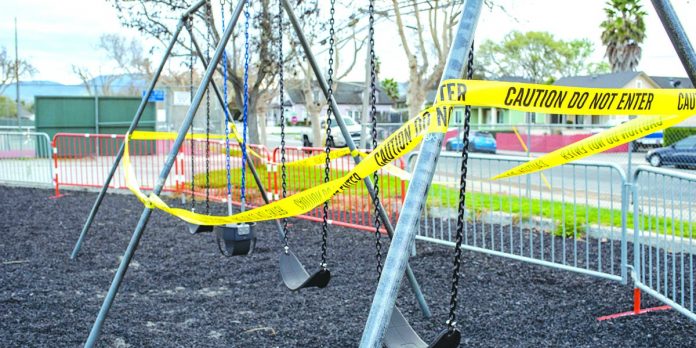Less than three hours after public health officials stunned San Benito county residents March 17 with an order to “shelter at their place of residence” for 20 days to slow the spread of the coronavirus, came another revelation: The virus had taken the life of the first county resident.
The victim was identified as an adult male in his 60s with underlying health conditions who had recently traveled to Thailand. He died the morning of March 16, and the next day it was determined he had been infected with COVID-19, according to a 5pm announcement from the county Health and Human Services Agency.
“This is a tragic development,” said Dr. Martin Fenstersheib, health officer for San Benito County. “San Benito County Public Health Services is working closely with its healthcare and community partners to take the necessary steps to slow down the spread of the disease and to protect those at greatest risk. Our top priority continues to be protecting the health of our community.”
The legal order to keep most residents in their homes was to go into effect at 12:01am on Wednesday, March 18. It limits all individual activity, travel and business functions to only the most essential needs, allowing an exemption for a range of specific business and services.
The order’s language matches similar directives announced Monday by seven Bay Area counties, including neighboring Santa Clara and Santa Cruz counties. Grocery stores, healthcare facilities, banks and farmers are among the exemptions listed. Restaurants may only provide food on a take-out basis.
Hollister Mayor Ignacio Velazquez said Monday he would be asking the county to implement the order. Approximately 70 percent of county residents live in Hollister. It is estimated that half of Hollister’s working population commutes to Santa Clara County, which has the most reported COVID-19 cases in the state.
The announcement at an afternoon press conference by Dr. Fenstersheib, San Benito’s County health officer, came four days after he alerted the public to one new case of COVID-19 in San Benito County. A second new case was revealed at Tuesday’s press conference.
The new cases are unrelated to the first two confirmed cases, announced at the start of the pandemic, on Feb. 2. Both the individuals have fully recovered, he said.
“While the number of cases in San Benito County remains small at this time, the public health department is preparing for those numbers to increase in the coming days and weeks including the probability of community spread,” he said March 13. “Given the geographical proximity of Santa Clara and Santa Cruz Counties, where community spread is extensive, many of the residents who commute for work and other reasons are at increased risk of exposure. In preparation for the continued response, the county has developed and distributed a physician and provider guidance on COVID-19 to assist the medical community in managing their patients and school guidance to assist the schools in navigating through COVID-19 preventative measures.
When county school officials announced a one-week school closure earlier in the afternoon, Fenstersheib recommended that students minimize social contact.
“Protecting public health requires a community-wide response,” he said at the time.
Tuesday’s announcement in Hollister capped a flurry of news breaking over the weekend and this week.
On Monday, March 16, all Santa Clara County schools began a three-week shutdown.
Gilroy fatality
Gilroy Mayor Roland Velasco announced Sunday that an 80-year-old Gilroy woman had become the second Santa Clara County fatality tied to COVID-19. County health officials had announced a second death March 13.
The Santa Clara Public Health Department Monday announced two more deaths from COVID-19, bringing the total number of deaths there to four. An adult man in his 80s was hospitalized on March 7 and died on March 15. An adult man in his 50s was hospitalized on March 12 and died on March 15.
On Monday, March 16, the Gilroy city council affirmed a local emergency proclamation to prepare for the growing spread of novel coronavirus (COVID-19) in the community. The proclamation is in effect through April 5.
Newsom, Trump
The original six-county order was announced one day after California Gov. Gavin Newsom urged all seniors over 65 years of age to “self-isolate” for an indefinite period, and at the same time President Donald Trump encouraged all U.S. citizens to avoid gathering in groups larger than 10 people, and avoid “discretionary travel, bars, restaurants and public food courts.” Trump warned the public to take these steps against “an invisible enemy” and acknowledged that a recession was a possibility.
Sunday evening, coronavirus questions topped the agenda of a presidential debate between Sen. Bernie Sanders and former Vice President Joe Biden.
Brewpubs, wineries
Also on Sunday, Newsom ordered the shutdown of California bars, nightclubs, brew pubs and wineries to help stop coronavirus’ spread. Newsom also said restaurants should reduce capacity by half and provide “deep social distancing.” Newsom said there should be no hospital visits, unless it was an “end of life” situation.
As of March 17, the state had confirmed 590 cases of the virus and recorded its 11th death. Also Monday, Newsom signed an executive order halting foreclosures and evictions in the state while also directing the state utilities commission to monitor efforts by companies to prevent utility shutoffs.
Violation is misdemeanor
In a stunning escalation of the battle against the coronavirus in one of the nation’s hotspots for the pandemic, the new public health order carries legal weight: Failure to comply with any of the provisions of order constitutes an imminent threat to public health—a misdemeanor punishable by fine, imprisonment, or both.
The order directs “all individuals living in the county to shelter at their place of residence except that they may leave to provide or receive certain essential services or engage in essential activities and work for essential businesses and governmental services” and directs all businesses and government agencies “to cease non-essential operations at physical locations in the county” and prohibits “all non-essential gatherings of any number of individuals and ordering cessation of all non-essential travel.”
Social distancing
“When people need to leave their places of residence, whether to obtain or perform vital services, or to otherwise facilitate authorized activities necessary for continuity of social and commercial life, they should at all times reasonably possible comply with social distancing requirements,” the order reads.
The “social distancing” requirements of the order states: “To the extent individuals are using shared or outdoor spaces, they must at all times as reasonably possible maintain social distancing of at least six feet from any other person when they are outside their residence.”
All persons may leave their residences only for “essential activities, essential governmental functions, or to operate essential businesses.”
Individuals experiencing homelessness are exempt from the order, “but are strongly urged to obtain shelter, and governmental and other entities are strongly urged to make such shelter available as soon as possible.”
For the complete text of the order, visit https://hhsa.cosb.us/publichealth/communicable-disease/covid19-press-release/










